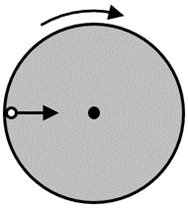A thin horizontal circular disc is rotating about a vertical axis passing through its centre. An insect is at rest at a point near the rim of the disc. The insect now moves along a diameter of the disc to reach its other end. During the journey of the insect, the angular speed of the disc:

From angular momentum conservation about vertical axis passing through centre. When insect is coming from circumference to center. Moment of inertia first decrease then increase. So angular velocity increase then decrease.
This problem involves the conservation of angular momentum in a rotating system. The disc is rotating about a fixed vertical axis. The insect, initially at rest near the rim, is part of this system. As the insect moves, it changes the system's mass distribution, which affects the moment of inertia. Since no external torque acts on the system (the axis is fixed and vertical, and gravity acts through the axis, providing no torque), the total angular momentum of the system (disc + insect) is conserved.
The angular momentum L is given by: where I is the moment of inertia and ω is the angular speed. Conservation means L is constant, so if I changes, ω must change to keep L the same:
Let's analyze the insect's journey along the diameter:
Step 1: The insect starts at the rim. At this point, its distance from the axis is maximum (R, the radius of the disc). The moment of inertia of the insect is , where m is its mass. This contributes significantly to the total moment of inertia of the system.
Step 2: As the insect moves inward towards the center, its distance from the axis (r) decreases. The moment of inertia of the insect is . Therefore, the total moment of inertia of the system (I_total = I_disc + I_insect) decreases because I_insect is getting smaller.
Step 3: Since angular momentum L is conserved (L = constant), a decrease in the total moment of inertia (I) must be accompanied by an increase in the angular speed (ω) to keep the product Iω constant.
Step 4: The insect reaches the center. Here, its distance from the axis is r=0, so its moment of inertia is 0. The total I of the system is at its minimum. Therefore, ω is at its maximum.
Step 5: Now the insect moves outward from the center towards the opposite rim. Its distance from the axis (r) increases again. Therefore, the moment of inertia of the insect ( ) increases, causing the total I of the system to increase.
Step 6: To conserve angular momentum (L = Iω = constant), this increase in I must be accompanied by a decrease in ω.
Conclusion: The angular speed first increases (as the insect moves inward) and then decreases (as the insect moves outward).
Final Answer: The angular speed of the disc first increases and then decreases.
Conservation of Angular Momentum: If the net external torque on a system is zero, the total angular momentum remains constant. This is a fundamental principle in rotational dynamics.
Moment of Inertia for a Point Mass: The moment of inertia I of a point mass m about an axis is given by , where r is the perpendicular distance from the axis of rotation. This is why the insect's position directly affects the system's total I.